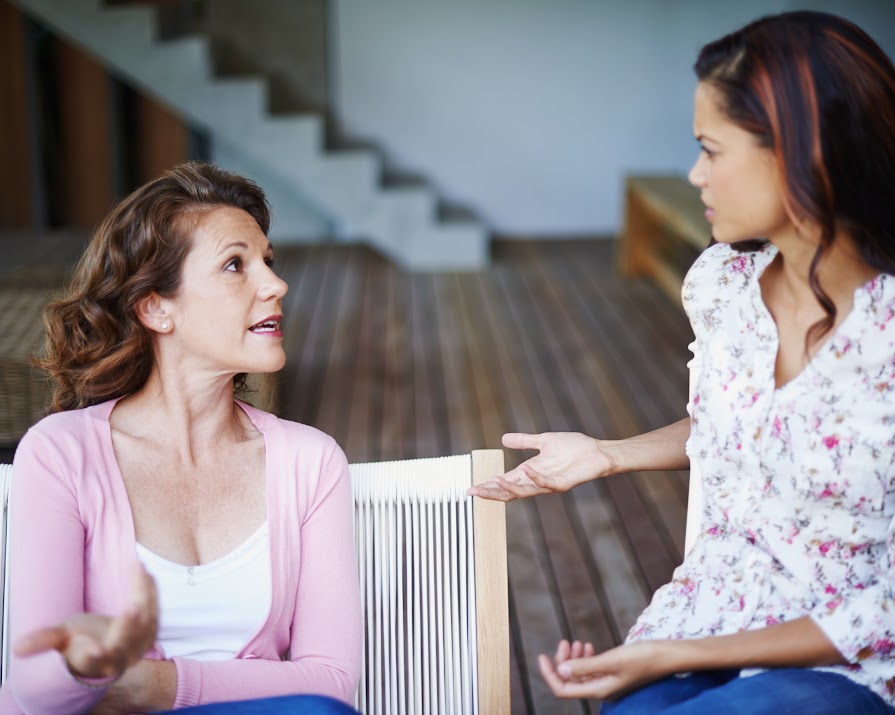
By Julie Meehan
24th Mar 2020
24th Mar 2020
In parenting terms, when your child does something that makes you feel suddenly very angry, hurt or helpless, you have been triggered. Here’s how to deal with it, identify your triggers and transform how you relate to yourself and your child
When it comes to our personal relationships, we all bump up against each other’s emotional edges. Be it your partner, sibling, work colleague, parent, neighbour, best friend or child, when we are in relationship, sooner or later, we find ourselves being triggered emotionally by them.
Emotional edges are our internal vulnerable spots, those places inside where our buttons get pushed by someone we are in relationship with, often leading us to experience difficult emotions. These can range from mildly irritated at one end of the spectrum to wildly enraged at the other end – and anything in between.
Following these difficult emotional experiences, we are often left wondering how we let ourselves get triggered yet again by the same person and in the very same way as last time. Especially when we swore we would never let it happen again.
While no one is exempt from being a potential button-pusher in your life, very often our children seem to be our greatest button-pushers of all. And whilst there are many, many ways in which we can be emotionally triggered by our children (and them by us), you may have noticed that there are usually a few primary patterns of behaviour that they show that really seem to activate you.
It’s almost as if your child has a particular emotional and behavioural signature that when revealed sends you into emotional over-drive.
Time for honesty
I call these patterns of behaviour the ‘triggery’ ones: the ways in which our children relate to us that really seem to push our emotional edges, sometimes to the brink of sanity. In my last post, I explored how the brain works when we get emotionally activated: the part of our brain that is governed by our emotions takes over and hijacks the rest of the brain, including the parts that mediate calm and logical thinking.
Knowing how the brain works in these circumstances has really helped me to stay more grounded and be kinder to myself when I find myself losing it with my children. What is as important as this is identifying what kind of patterns of behaviours in your children trigger you, and why.
While I have been a parent for over eight years, and a psychologist for longer, it is only very recently that I gave myself the space, time and safety to explore what it is exactly in my children’s patterns of relating that really activates me. I won’t lie, the process of noticing how I am being triggered, and more importantly, why, has been a painful one at times.
It has taken an unflinching willingness to look at parts of myself that I would rather not and an honesty to admit that it is my responsibility as the adult in the relationship to engage in my own self-examination, for my sake and for the benefit of my children and my whole family.
“I realised I get supremely activated when I feel that my children are not listening to me. And rage ensues.”
While we can’t directly change anyone else’s behaviour or attitudes, we can make a commitment to ourselves: a commitment to exploring what we would like to see changing in how we relate to others, and ultimately to ourselves.
Find your edge
What I discovered when I began to notice my triggers may come as no surprise to any parent, but to me it felt like a pure insight about my children’s behaviour had been dropped into my awareness that up until that point had been hidden in plain sight. I realised I get supremely activated when I feel that my children are not listening to me. And rage ensues. Whilst this may not seem like an earth-shattering epiphany to some, to me it felt like clouds clearing on a murky day to reveal a pristine blue sky. Of course it enrages me no one likes to be ignored, as if they are not seen, felt or heard.
In essence, what I did was trace the top note of my emotional edge – the trigger – all the way down to core parts of me that still felt unheard and unseen in some way. Only then, when I recognised what parts of me were being pushed, and why, could I sit with myself, and allow those parts of myself to be heard, to be witnessed, by no-one else but myself. And in so doing, those parts of me seemed to have become quieter, softer, and the rage is less.
While applying practices like this one doesn’t always take the shape of a neat four-point plan, here are some suggestions for how you might approach this for yourself:
Pause & recognise:
When you find yourself being triggered emotionally by your child, pause, take a deep breath, and recognise what is happening. Without judgement, invite yourself to acknowledge that one of your buttons has been pushed, and make a mental note of what it is in their behaviour that is triggering you.
Given that your emotions may be high, and the part of your brain that oversees logical thought might not be fully operational, this might be a word, or a short sentence, such as ‘he’s ignoring me!!’.
You may not be able to put words to your experience, and if so, just paying attention to how you are feeling can be helpful (eg: ‘Naming it to tame it’). If you can, flag whatever you have recognised or identified for later.
Sit down & sit with yourself:
At some point later, when you have some time to yourself, and the exchange between you and your child has passed, give yourself some time to sit down and sit with yourself. If at all possible, try to carve out a time and a space where you will not be interrupted.
As much as you can, be kind and open with yourself. Write down what you recognised and felt during the triggery exchange: for me it was ‘Ignored’, ‘Enraged’.
If the same emotions come up again, stay with the process, by feeling your breath in your body and your feet on the floor, and remember that you are consciously choosing to give your attention to parts of you that may be tender and vulnerable.
Question the triggers:
Inviting in patience, ask yourself the questions: ‘Why might I be triggered by this feeling?’, ‘Is this familiar?’, ‘Have I ever felt like this before?’. Again, stay with yourself, and see what comes up. If it feels like too much, know your own limits and know that you can stop at any time.
If you can stay with it, write down the feelings that arise and the memories that may accompany them. In so doing, you may begin to see a pattern that you can trace back to some core invalidating experience. You might recall a particular episode, or just an overall sense of a feeling, like I did when I realised that I get triggered by being ignored, because when I am ignored, it feels like I don’t matter.
Be available to yourself for yourself :
With great kindness, see if you can now give attention to that part of you that feels like it is still experiencing that sense of invalidation. You might find that simply sitting quietly and keeping your attention on your breath is enough. Or you might want to imagine that you are sitting with that part of you, and you are keeping them company as you sit quietly together. Or you might want to speak to them, letting them know that you are here and ready to be present with them.
You may find your own unique way of being available to yourself and for yourself. Trust what feels right for you.
The goal is to consciously acknowledge your emotional edges, and with compassion, follow them back to their root, where they can be lovingly met.
Like so much of our human experience, this process may take time, practice, commitment and great courage, but what you might begin to find is that your emotional edges start to soften, creating more space and new opportunities to flourish in how you and your children relate to each other.
Dr Julie Meehan is a clinical psychologist, parent coach, work-shop facilitator and mum. She works offers individual parenting support sessions online and in person, as well as workshops nationwide. She lives in the northwest with her two children, her ‘very greatest’ teachers.
For more: www.juliemeehan.com or email: juliemeehan@gmail.com.
Read more: Three steps to boost your child’s emotional regulation
Read more: When everything seems too much…
Read more: Helping your child with separation anxiety























